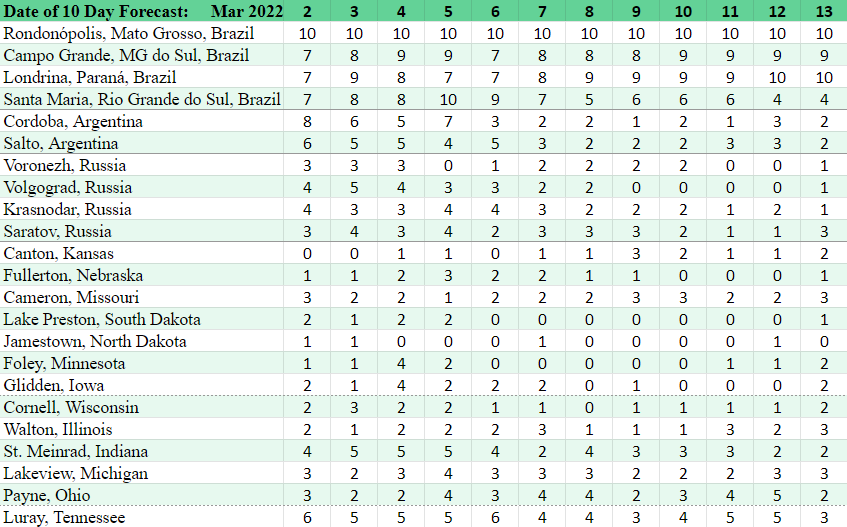US Embassy Attack, Argentina, Fertilizers, China Wheat, BC Vote & Rain Days Update 03/13/2022
- Wright Team

- Mar 13, 2022
- 3 min read
Twelve ballistic missiles hit near the US consulate in Erbil in Northwestern Iraq Saturday (last) night. Tracking the trajectory of the missiles show they were launched from Iran. There were damages, but no casualties reported as of early this morning.
Iran’s national news reported 6 Long Range Ballistic Missiles were launched towards the US embassy at Erbil and the embassy compound was hit.
Biden was counting on buying crude oil from Iran since he lifted Trump sanctions on Iran. Now what will he do? Our guess is he will still buy Irianian crude oil.
Russia announced yesterday Moscow’s stock market will be closed all of this week.
Robin Brooks is the Chief Economist for the Global Association of the Financial Industry. He predicts Russia's GDP will fall 30% by the end of 2022 as sanctions choke-off domestic demand. He expects Russia to print new money to ease the economic pain. He says, “…but that'll just bring a devaluation-hyperinflation spiral…” Russia is by far the world’s largest wheat exporter. Will growing crops become the most important industry in Russia? Or will the farming business die a slow death as it is in Argentina?
Argentina ended 2021 with the same number of private jobs as 2011. However, during those same ten years 842,000 public jobs were added. Argentina has defaulted on its national debt three times in the last 30 or so years.
The government’s main source of income is export taxes on agriculture products. Until last 2020, Argentina was the world’s largest export of soybean meal and soy oil. In late 2020, much of its crushing capacity was shut-down for about ten months due to financial constraints from the government.
Argentina’s inflation in 2021 was a bit more than 50% because the government keeps the economy alive with newly printed money. That is what socialist governments have to do to sustain economic activity.
How many more years will Argentina continue to be the world’s third largest exporter of corn and the third largest producer of soybeans?
Ukraine banned fertilizers exports, not that they were going to export any this spring.
Warm weather in Ukraine has turned cold for an extended time, delaying the spring crops plantings by 2-3 weeks. Corn planting usually starts after April 15-20. The delay will allow more time for farmers and input suppliers to develop more adequate logistics. Ukraine’s winter wheat is in good condition. Ukraine’s farmers are thinking no field work this spring after dark. The lights will make them sitting ducks for aircraft attacks.
Agrinvest Commodities of Brazil has been a trader of physical agricultural commodities for 35 years. Saturday afternoon, they informed their fertilizer clients, We started to hear Russian fertilizer offers at a huge discount compared to other origins. We have already seen this movement with crude oil, for example, now the "x" of the question is: Will we have buyers? How will we do the payment and logistics? These are the gaps of the moment!
China’s annual wheat production has leveled off at about 135 million mt, which China consumes almost all of it. All the other wheat producing countries of the world grow about 145 million mt of wheat each year. China imported twice as much wheat on average the past two years as it averaged the previous four years. China has some agronomists who say China’s 2022 winter wheat crop is the “worst in history”. If China’s appetite for wheat continues to grow as it has the past three years, this new demand will change the dynamics of the world wheat market and change the acreages of all other crops. The question is by how much?
China’s wheat imports graph:

Rain Days Update
Yesterday, in the dry areas of South America: Santa Maria high temperature 81°F with 0 inches rain. Cordoba high temperature 84°F with 0 inches rain. Salto high temperature 83°F with 0 inches rain. Total rainfall and temperatures expected in the next ten days: Santa Maria 0.33 inches, 70 to 89°F. Cordoba 0.12 inches, 65 to 90°F. Salto 0.10 inches, 70 to 88°F.
The Western Corn Belt has 6 more rain days in the 10 day forecast than yesterday and the Eastern Corn Belt has 1 less rain days than yesterday.





Comments